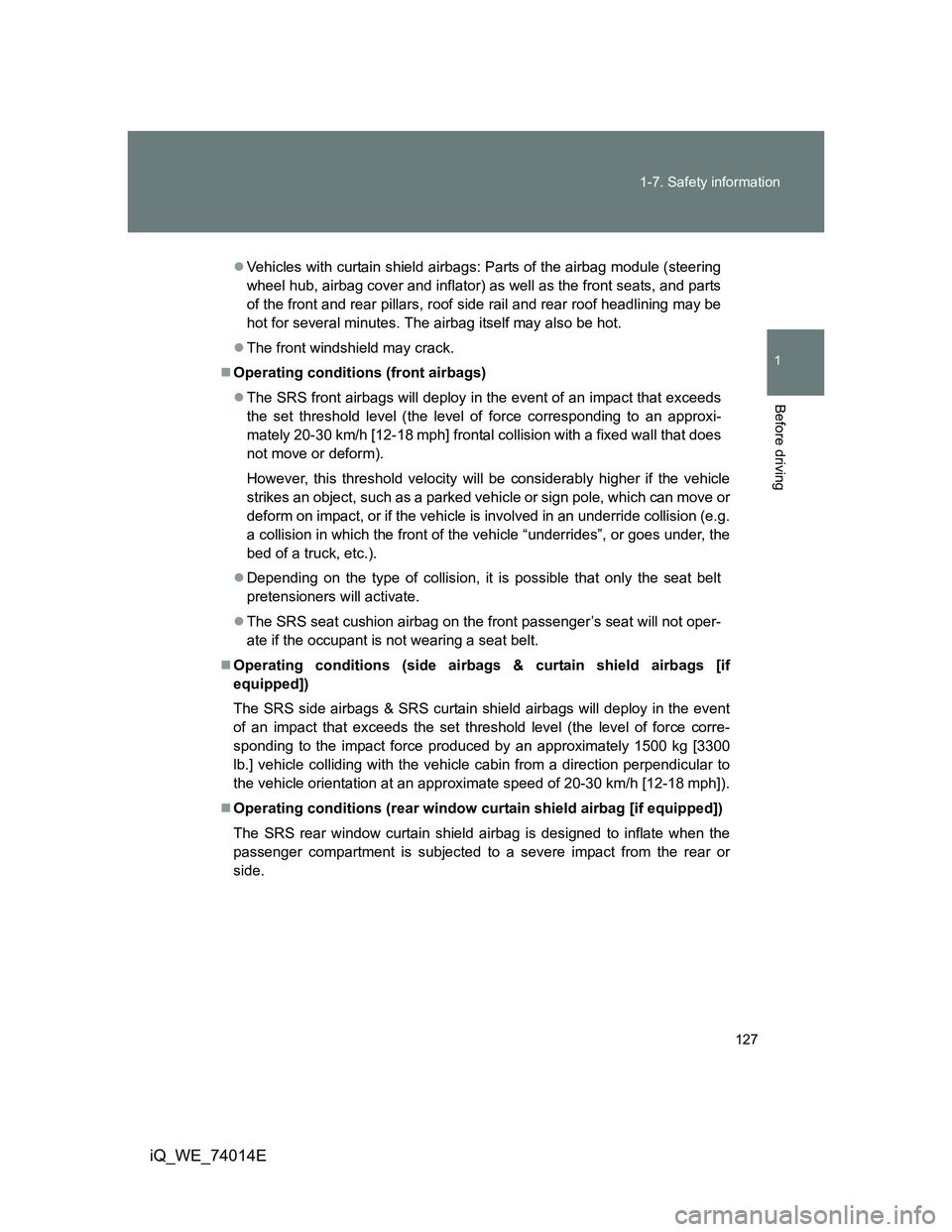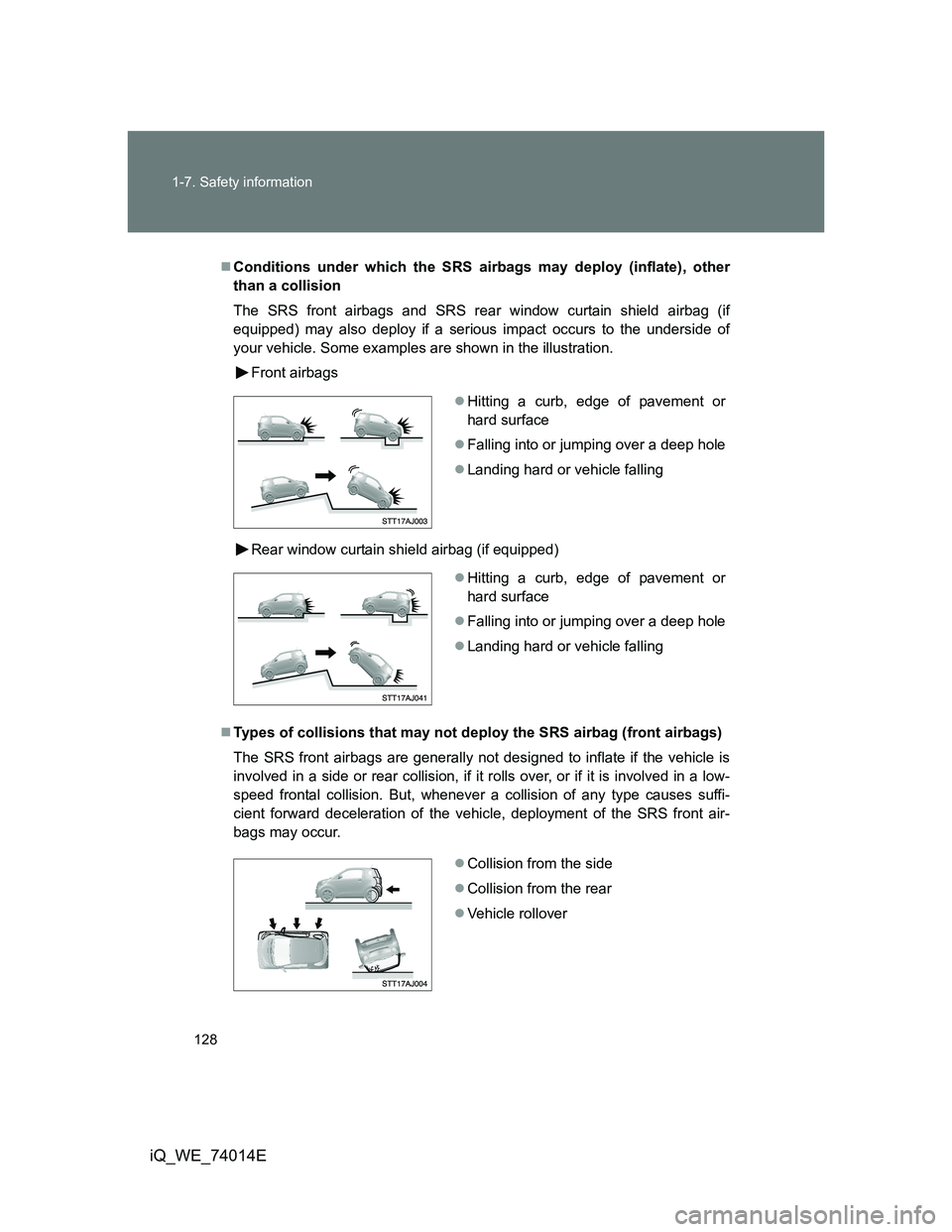Page 127 of 476

127 1-7. Safety information
1
Before driving
iQ_WE_74014E
Vehicles with curtain shield airbags: Parts of the airbag module (steering
wheel hub, airbag cover and inflator) as well as the front seats, and parts
of the front and rear pillars, roof side rail and rear roof headlining may be
hot for several minutes. The airbag itself may also be hot.
The front windshield may crack.
Operating conditions (front airbags)
The SRS front airbags will deploy in the event of an impact that exceeds
the set threshold level (the level of force corresponding to an approxi-
mately 20-30 km/h [12-18 mph] frontal collision with a fixed wall that does
not move or deform).
However, this threshold velocity will be considerably higher if the vehicle
strikes an object, such as a parked vehicle or sign pole, which can move or
deform on impact, or if the vehicle is involved in an underride collision (e.g.
a collision in which the front of the vehicle “underrides”, or goes under, the
bed of a truck, etc.).
Depending on the type of collision, it is possible that only the seat belt
pretensioners will activate.
The SRS seat cushion airbag on the front passenger’s seat will not oper-
ate if the occupant is not wearing a seat belt.
Operating conditions (side airbags & curtain shield airbags [if
equipped])
The SRS side airbags & SRS curtain shield airbags will deploy in the event
of an impact that exceeds the set threshold level (the level of force corre-
sponding to the impact force produced by an approximately 1500 kg [3300
lb.] vehicle colliding with the vehicle cabin from a direction perpendicular to
the vehicle orientation at an approximate speed of 20-30 km/h [12-18 mph]).
Operating conditions (rear window curtain shield airbag [if equipped])
The SRS rear window curtain shield airbag is designed to inflate when the
passenger compartment is subjected to a severe impact from the rear or
side.
Page 128 of 476

128 1-7. Safety information
iQ_WE_74014E
Conditions under which the SRS airbags may deploy (inflate), other
than a collision
The SRS front airbags and SRS rear window curtain shield airbag (if
equipped) may also deploy if a serious impact occurs to the underside of
your vehicle. Some examples are shown in the illustration.
Front airbags
Rear window curtain shield airbag (if equipped)
Types of collisions that may not deploy the SRS airbag (front airbags)
The SRS front airbags are generally not designed to inflate if the vehicle is
involved in a side or rear collision, if it rolls over, or if it is involved in a low-
speed frontal collision. But, whenever a collision of any type causes suffi-
cient forward deceleration of the vehicle, deployment of the SRS front air-
bags may occur.
Hitting a curb, edge of pavement or
hard surface
Falling into or jumping over a deep hole
Landing hard or vehicle falling
Hitting a curb, edge of pavement or
hard surface
Falling into or jumping over a deep hole
Landing hard or vehicle falling
Collision from the side
Collision from the rear
Vehicle rollover
Page 129 of 476
![TOYOTA IQ 2012 Owners Manual 129 1-7. Safety information
1
Before driving
iQ_WE_74014E
Types of collisions that may not deploy the SRS airbag
(side airbags and curtain shield airbags [if equipped])
The SRS side airbag and cur TOYOTA IQ 2012 Owners Manual 129 1-7. Safety information
1
Before driving
iQ_WE_74014E
Types of collisions that may not deploy the SRS airbag
(side airbags and curtain shield airbags [if equipped])
The SRS side airbag and cur](/manual-img/14/60097/w960_60097-128.png)
129 1-7. Safety information
1
Before driving
iQ_WE_74014E
Types of collisions that may not deploy the SRS airbag
(side airbags and curtain shield airbags [if equipped])
The SRS side airbag and curtain shield airbag (if equipped) system may not
activate if the vehicle is subjected to a collision from the side at certain
angles, or a collision to the side of the vehicle body other than the passenger
compartment.
The SRS side airbags do not generally inflate if the vehicle is involved in a
frontal or rear collision, if it rolls over, or if it is involved in a low-speed side
collision.
Vehicles with SRS curtain shield airbags: The SRS curtain shield airbags do
not generally inflate if the vehicle is involved in a frontal collision, if it rolls
over, or if it is involved in a low-speed side or low speed rear collision.
Collision from the side to the vehicle
body other than the passenger com-
partment
Collision from the side at an angle
Collision from the front
Collision from the rear
Vehicle rollover
Collision from the front
Vehicle rollover
Page 130 of 476
![TOYOTA IQ 2012 Owners Manual 130 1-7. Safety information
iQ_WE_74014E
Types of collisions that may not deploy the SRS airbag
(rear window curtain shield airbag [if equipped])
The SRS rear window curtain shield airbag is gener TOYOTA IQ 2012 Owners Manual 130 1-7. Safety information
iQ_WE_74014E
Types of collisions that may not deploy the SRS airbag
(rear window curtain shield airbag [if equipped])
The SRS rear window curtain shield airbag is gener](/manual-img/14/60097/w960_60097-129.png)
130 1-7. Safety information
iQ_WE_74014E
Types of collisions that may not deploy the SRS airbag
(rear window curtain shield airbag [if equipped])
The SRS rear window curtain shield airbag is generally not designed to
inflate if the vehicle is involved in a front collision, if it rolls over, or if it is
involved in a low-speed rear or low-speed side collision.
When to contact any authorized Toyota dealer or repairer, or another
duly qualified and equipped professional
In the following cases, contact any authorized Toyota dealer or repairer, or
another duly qualified and equipped professional, as soon as possible.
Any of the SRS airbags have been inflated.
Collision from the front
Vehicle rollover
The front of the vehicle is damaged or
deformed, or was involved in an acci-
dent that was not severe enough to
cause the SRS airbags to inflate.
A portion of a door is damaged or
deformed, or the vehicle was involved
in an accident that was not severe
enough to cause the SRS side airbags
and curtain shield airbags (if equipped)
to inflate.
Page 131 of 476

131 1-7. Safety information
1
Before driving
iQ_WE_74014E
Vehicles with rear window curtain shield
airbag: The rear of the vehicle is dam-
aged or deformed, or the vehicle was
involved in an accident that was not
severe enough to cause the SRS rear
window curtain shield airbag to inflate.
The pad section of the steering wheel
or dashboard near the front passenger
airbag cover or lower portion of the
instrument panel is scratched, cracked,
or otherwise damaged.
Front passenger seat: The seat cushion
surface is scratched, cracked, or other-
wise damaged.
The surface of the seats with the side
airbag is scratched, cracked or other-
wise damaged.
Vehicles with curtain shield airbags:
The portion of the front pillars, rear pil-
lars or roof side rail garnishes (padding)
containing the curtain shield airbags is
scratched, cracked or otherwise dam-
aged.
Vehicles with rear window curtain shield
airbag: The portion of the rear roof
headlining or rear pillars containing the
rear window curtain shield airbag is
scratched, cracked or otherwise dam-
aged.
Page 132 of 476

132 1-7. Safety information
iQ_WE_74014E
CAUTION
SRS airbag precautions
Observe the following precautions regarding the airbags.
Failure to do so may cause death or serious injury.
The driver and all passengers in the vehicle must wear their seat belts
properly.
The SRS airbags are supplemental devices to be used with the seat belts.
The SRS driver airbag deploys with considerable force, and can cause
death or serious injury especially if the driver is very close to the airbag.
Since the risk zone for the driver’s airbag is the first 50 - 75 mm (2 - 3 in.) of
inflation, placing yourself 250 mm (10 in.) from your driver airbag provides
you with a clear margin of safety. This distance is measured from the center
of the steering wheel to your breastbone. If you sit less than 250 mm (10 in.)
away now, you can change your driving position in several ways:
• Move your seat to the rear as far as you can while still reaching the
pedals comfortably.
• Slightly recline the back of the seat.
Although vehicle designs vary, many drivers can achieve the 250 mm
(10 in.) distance, even with the driver seat all the way forward, simply
by reclining the back of the seat somewhat. If reclining the back of your
seat makes it hard to see the road, raise yourself by using a firm, non-
slippery cushion, or raise the seat if your vehicle has that feature.
• If your steering wheel is adjustable, tilt it downward. This points the air-
bag toward your chest instead of your head and neck.
The seat should be adjusted as recommended above, while still maintaining
control of the foot pedals, steering wheel, and your view of the instrument
panel controls.
The SRS front passenger airbag also deploys with considerable force, and
can cause death or serious injury especially if the front passenger is very
close to the airbag. The front passenger seat should be as far from the air-
bag as possible with the seatback adjusted, so the front passenger sits
upright.
Page 133 of 476

133 1-7. Safety information
1
Before driving
iQ_WE_74014E
CAUTION
SRS airbag precautions
Improperly seated and/or restrained infants and children can be killed or
seriously injured by a deploying airbag. An infant or child who is too small
to use a seat belt should be properly secured using a child restraint sys-
tem. Toyota strongly recommends that all infants and children be placed in
the rear seats of the vehicle and properly restrained. The rear seats are
the safest for infants and children. (P. 137)
Do not sit on the edge of the seat or
lean against the dashboard.
Do not allow a child to stand in front of
the SRS front passenger airbag unit or
sit on the knees of a front passenger.
Do not drive the vehicle while the driver
or passenger has items resting on their
knees.
Vehicles without curtain shield airbags:
Do not lean against the front door.
Vehicles with curtain shield airbags: Do
not lean against the door, the roof side
rail or the front, side and rear pillars.
Page 134 of 476
134 1-7. Safety information
iQ_WE_74014E
CAUTION
SRS airbag precautions
Do not allow anyone to kneel on the
passenger seat toward the door or put
their head or hands outside the vehicle.
Vehicles with rear window curtain shield
airbag: Do not allow anyone to kneel on
the rear seat toward the back door.
Do not attach anything to or lean any-
thing against areas such as the dash-
board, steering wheel pad or lower
portion of the instrument panel.
These items can become projectiles
when SRS driver, front passenger and
knee airbags deploy.
Do not put objects on the front passen-
ger seat cushion.